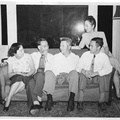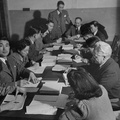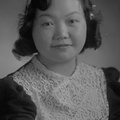Read Part 1 >>
Professor Eckhardt brought Boothroyd's plan to the December 8, 1938, meeting of the Faculty Senate. To have described the faculty's response as unenthusiastic would have been an overstatement. The faculty's initial apprehension and skepticism may have had less to do with the question of segregation and more to do with the students' risky plan to address it. Many of the professors might have guessed that the student body would not answer as Boothroyd and his classmates anticipated. A vote denouncing segregation, with accompanying uncontrollable publicity, might have been embarrassing and problematical for minority rights, but a student vote endorsing segregation would have far worse consequences. It was fortuitous that the faculty acted as they did.
Fortune Magazine's first national opinion poll, in 1939, would show that a meager 19 percent of Northeastern respondents favored allowing blacks "to live wherever they wanted to live." Only 12 percent of Midwestern respondents supported such residential desegregation. Eckhardt may have thought that one ought not to pose a question of such import in a public forum unless one is certain of the answer.1
As the Faculty Senate meeting progressed, several views were put forward expressing a range of opinion on whether or not, and by what method, to mandate social justice. Professor Eckhardt questioned the wisdom of publicly raising the issue, firmly believing that such a course would cement opposition. Dean of the Law School Robert Stearns wondered whether the University ought to take on social problems, suggesting that the student union, ASUC, should handle the issue.Professor Earl Swisher (East Asian history professor) cited the success which attended the efforts of Harvard University and the University of California on behalf of equal rights for all students.Graduate School Dean O.C. Lester appeared to feel that provoking the community and the students on this matter would worsen conditions.
Professor Joseph Cohen (Philosophy) motioned that a committee be formed to study the issue to determine the extent of campus and community discrimination and report on possible solutions. The committee formed with Eckhardt as chair, and Stearns and Swisher as members. The Faculty Senate concluded by echoing Eckhardt's desire for discretion in the investigation. All feared publicity and the probable repercussions a publicly held probe would have on minority students.2
Their February 9, 1939, report, issued just two months later, was both a statistical measurement of minority attendance at CU and a barometer of racial and ethnocentric behavior in 1939.3 Statistically, there were 23 students enrolled as Europeans, but with no more than four for any one nationality, none were counted as “minorities.” Four Chinese students were in attendance, "only one of the four is an American citizen."4 They also were not counted as a group, since none expressed feelings of discrimination or problems rising from their nationality or religion. Three groups were determined, by numbers and treatment, to justify consideration by the Faculty Senate committee: Jews, Japanese, and blacks.
There were at least 86 Jewish students attending CU in 1938, practically all were U.S. citizens. Seventeen Japanese students were attending the university, all of whom were citizens, 14 of whom were Colorado residents. Hence, virtually all students under consideration were American citizens, since few, if any other nationals appeared in sufficient numbers or complained of discriminatory treatment. Perhaps in 1938, few international students could complain of the American version of the virulent racism abroad in Europe and Asia. Interestingly, although Hispanic students numbered more than 15 and as many as 23, they were not considered as a minority group.5
Female Japanese-ancestry students complained that they frequently were refused housing on the grounds that white females would object, an eventuality the Japanese American women had not yet encountered. They believed increased tension over the Sino-Japanese war had aggravated anti-Japanese discrimination in Boulder, despite the fact that these women were American citizens.
The 1939 faculty investigation would launch, by fits and starts, a 30-year period of the desegregation practiced on an off campus. Desegregation would require the exhaustive and continual examination of racial and ethnic segregation within both the university and the Boulder community. It would demand the development of a sweeping reevaluation of the university's position within the larger community, as well as creating new responsibilities which assuming that position would entail. The desegregationist drive would start on campus in honoraries, extend to the merchants, landlords, and civic officials of Boulder, reach university athletics, and culminate in a face-off with fraternities and sororities. Consensus on campus was not always achieved. Outside opposition was often fierce. Yet the plan so brashly presented by white undergraduates to Professor Eckhardt would provide a fulcrum around which race relations at the university would turn irrevocably.6
At the February 9, 1939, meeting of the Senate, Eckhardt's committee presented a 14-page report of their findings and recommendations. In the report, they reiterated their initial reluctance to take on such a project. But after consideration, the committee came to the realization that the problems needed a thorough examination in light of federal and state law and regulations. They stated that such laws must be applied both on and off campus to "preserve democracy with reference to minority rights." Having taken such measures to insure equality on campus, the committee believed that they should inform the "townsmen" of the law. Not convinced that the outside community would support their plan, the committee suspected that they would need to develop policies which would protect minority students should "hearty cooperation of extra-mural groups fail to materialize."7
The ASUC formed a Committee on Minorities, and with Faculty Senate approval, sent a letter to the businesses on the Hill, citing incidents of discrimination against black, Japanese, Chinese, and Jewish students. The letter exhorted the businesses to end their discrimination and extend the same privileges to all students of the university irrespective of race and color. Investigations of conditions on the Hill would follow the business owners' responses throughout the next six years.8
The committee had several suggestions for immediate action. Since minority housing seemed the most pressing concern, they recommended that the University Housing Committee investigate rooming houses to determine which houses would accommodate minority students. The University Housing Committee was urged to gently point out to rooming house operators that the university housing bureau's job was to direct all student patrons to off campus housing, "in consideration thereof the operators should be made aware of the need of cooperating in all respects." No need for campus officials to be too blunt. If campus officials failed to gain cooperation from the townspeople, then the university should look into creating an International House, which would include a barbershop. Such an International House could provide room and board to minority students who could not find convenient accommodations elsewhere.
Minority and liberal white students helped to locate suitable "international" houses, painted and repaired the structures, fixed the plumbing, and rendered the buildings livable. In September, 1941, their International Co-operative House for Men at 1105 College Avenue and an International Co-operative House for Women at 1002 Mapleton were opened by the university as a partial solution to inadequate segregated housing in Boulder. Housing for a total of 19 minority students in the fall of 1941, the International Houses also provided a less hostile environment than those found in the dormitories. Mayford Roark, who had written on racial relations in the Silver & Gold, was named manager of the men's International House.
The onset of World War II brought new requirements and exigencies to the university. While the International House for Women survived war reorganization, the departure of the male students to the armed services severely curtailed pre-war men's organizations, including the International Co-operative House for Men, which did not appear in student directories after 1941.9
By the end of 1941, much progress had been made on the problems surrounding black segregation and discrimination. Unfortunately for the university, the problem was neither black and white, nor only about blacks and whites. Into this climate of intensifying racial debate, Japanese American students were arriving in growing numbers. Their presence on campus had already posed a challenge to both those who equated Japanese Americans with the Japanese Empire and those who attempted to protect their rights as American citizens.
After Pearl Harbor, the majority's correlation of Japanese enemy with Japanese American students would magnify this challenge. Part of the reason for increasing Japanese American attendance at the university was the February 19, 1942, Executive Order 9066, which evicted Japanese and Japanese Americans from the Pacific Coast and detained them in inland concentration camps, one of which, Granada, or Amache, was located in southeastern Colorado. The other reason was the transfer of the U.S. Navy Japanese Language School from the University of California at Berkeley to the University of Colorado in 1942, also largely caused by EO 9066. Moreover, Japanese Americans had already been involved in the civil rights debate. They had been prominent members of the Peace Council, Cosmo Club, and the Student Ethnic Minorities Committee, besides being involved in a wide array of student activities. Several were living in the International House for Women.10

George Y. Masunaga (1941) is 2nd row center, on the Big Six championship CU baseball team. The Coloradan of 1941, Volume 43, (Boulder, CO: Associated Students of the University of Colorado, 1941), p. 159.
The anti-discrimination effort was no longer largely a white led campaign, either. Soon after the first wartime semester began, minority women gave readings of W. E. B. DuBois and Richard Wright and played a recording of Paul Robeson in Sunday Chapel. The Student Ethnic Minorities Committee began to sponsor forums to further tolerance. On the 25th of February, 1942, Chinese, Japanese, black, and Hispanic students spoke at an all-racial conference. The conference, the first of its kind, was supported by the YWCA, Cosmo Club, Delta Epsilon Rho, Dialectica, the Campus Peace Council, the Forensic Association and the American Student Union.11
Prior to the fall of 1942, the number of Japanese Americans attending CU never seemed to rise above 20. In February and March of 1942, the presidents of a number of coastal universities appealed to other universities and colleges to accept the students affected by EO 9066. During their March 20 and 22, 1942, meetings the University of Colorado Board of Regents voted to accept self-supporting Japanese Americans, subject to the clearance by the FBI and the Commandant of the 12th Naval District. These Japanese Americans would not be eligible for classes covering confidential information. As President Stearns’ proposed, the Regents placed no ceiling on Japanese American attendance save the "limits of our facilities." However, the FBI and the army objected and directed the university consult with the City of Boulder. On July 10, Professor W.F. Dyde, assistant to the president, proposed to the Regents that the maximum enrollment be "not more than 60 non-resident American born Japanese students." Furthermore, he proposed the quota be distributed throughout the colleges. The Boulder City Council unanimously supported the actions of the Regents. Japanese American attendance more than doubled in 1942-43, peaking at 72 in 1944-45, and dropped to 71 in 1946-47. Between 60 percent and 75 percent of these were Colorado residents, reflecting not so much the acceptance of West Coast Japanese Americans, but either recent immigration to Colorado prior to and immediately following EO 9066, or the redirecting of Colorado students from West Coast institutions back to their home state. Since no more than 25 non-resident Japanese Americans were ever listed in the student directories, this 1942 limitation seems to have been somewhat cosmetic and unnecessary.12
Notes:
1. see the discussion of Southern and Northern attitudes toward blacks and segregation in Stephen Thernstrom and Abigail Thernstrom, America in Black and White: One Nation, Indivisible (New York: Simon & Schuster, 1997), 51-68; of course this would not be the last time student activists would assume their views were those of the student majority.
2. It is unclear what Professor Swisher meant by this. Harvard did not seem to have addressed its discriminatory residence hall practices prior to 1940, and its administration seemed unlikely promoters of off campus desegregation. See Seymour Martin Lipset and David Riesman, Education and Politics at Harvard (New York: McGraw-Hill Book Company, 1975) 142-145 and Richard Norton Smith, The Harvard Half Century: the Making of a University to a Nation (New York, Simon & Schuster, 1986), 85-89; at U.C. Berkeley, in 1937, liberal students in the ASUC. had ignored university administration resistance and objections to address discriminatory off-campus housing practices through boycotts and petitions, along with endorsement of non-discriminating landlords, see Verne A. Stadtman, The University of California, 1868-1968 (New York: McGraw-Hill Book Company, 1970), 291-93.
3. What follows is from the Senate Committee Report on the Minority Problem at the University of Colorado, Minutes of the Senate, 1924-1939, [Appendix between Pp. 156 and 157].
4. The casual lumping of foreign nationals with citizens of similar ethnicity and of all minority ethnicities, both foreign nationals and U.S. citizens, appears throughout this report; see notes 10 and 19.
5. Spanish surnames are not easily separated from Italian surnames, of which there were many more in attendance; see University of Colorado Directory, 1938-1939 (Boulder, CO: University of Colorado, 1938).
6. While both Harvard University and the University of California at Berkeley had attempted to address these issues previously, further research must be conducted to determine the degree to which the University of Colorado was exceptional in its efforts to desegregate itself and its outside community.
7. Senate Committee Report on the Minority Problem; the following paragraphs are drawn from a draft version of the same report, p. 12, C.C. Eckhardt Collection, 1-17.
8. President's Office Papers, I-56-1; "Committeemen Ask for No Racial Discrimination," Silver & Gold, October 6, 1939, 6.
9. Harry E. Groves to David Hays, June 2, 1998; "Racial Minorities Find Housing in New International Cooperative Houses," Silver & Gold, September 25, 1941, 1; Student and Faculty Directory, University of Colorado, 1938-1943; Vivian Marinoff, "Harmony Reigns Among Races Here," Silver & Gold, January 13, 1942, 2.
10. The class of 1940 had such graduates as Ruth Chiyeko Inabu of Crowley, Colorado, Treasurer of Delta Sigma Rho, Phi Gamma Mu, President of Women's Forensic Society, American Student Union, Secretary of the Cosmo Club, President of the Peace Council, Klinger Oration Winner, Delta Sigma Rho Extemporaneous Speech Winner, BA; Kumi Matsusaki of Mesilla, NM, Rx. Club, secretary of A.C.S., Cosmo Club, International Relations Club, University Choir, BS Pharmacy; 1941 had George Y. Masunaga of Brighton, CO, Mortar & Pestle, Cosmo Club, Buff Ski Club, Alpine Ski Club, Baseball, Intramurals, BS Pharmacy; 1942 featured such graduates as Eijiro Kaneshiro of Hawaii, Cosmo Club, Varsity Wrestling, BS Business; Seiken Nakayema of Littleton, CO, A.S.M.E., Cosmo Club, BS Engineering; Kisa Noguchi of Atwood, CO, secretary and president of Delta Phi Delta, Cosmo Club, U.W.C., Fencing Club, Junior Artist Guild, BFA with Honors; Trooda Oda of Grand Junction, CO, Cosmo Club, Orchestra, BME; see Coloradan, 1940-1942, 64,68; 53; 69,73,74; for more on Japanese Americans on college campuses during World War II, see Thomas James, “‘Life Begins with Freedom': The College Nisei, 1942-1945," History of Education Quarterly, 25, Nos. 1-2 (1985): 155-74.
11. Racial Equality to be Stressed in Sunday Chapel," and "Race, Religion War & Democracy," Silver & Gold, February 20, 1942, 1; "Speakers Represent Chinese, Japs, Negroes, Mexicans at First All-Racial Conference Tomorrow," Silver & Gold, February 24, 1942, 1, 2; "Japanese-Americans on Campus Express Desire to help U.S.," Boulder Daily Camera, February 26, 1942, 7; Harry E. Groves to Robert L. Stearns, February 23, 1942, Presidents Office Papers, I-56-1, AUCBL.
12. see Donald Paul Irish, "The Reactions of Residents of Boulder, Colorado to the Introduction of Japanese into the Community," M.A. Thesis, University of Colorado, 1950, Appendix II, 173; Colorado University Student Directory, 1938-39-1943; Colorado University Student Directory, 1944-1948; Board of Regents' Minutes, January 1942-December 17, 1943, Pp.32-33,54,72,73, AUCBL; "CU to Admit Japanese from Coast Colleges," Boulder Daily Camera, March 25, 1942, 1; W.F. Dyde to Robert L. Stearns, July 23, 1942, Robert L. Stearns Collection, 21-1, AUCBL; the University of Kansas Regents rejected the University of Kansas President's appeal to accept Japanese American students throughout the war, see Clifford S. Griffin, The University of Kansas: A History (Lawrence: University Press of Kansas, 1974), 497-98.
© 2014 David M Hays






